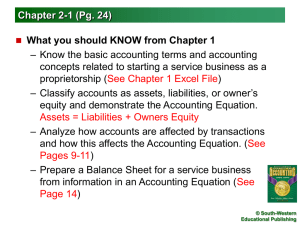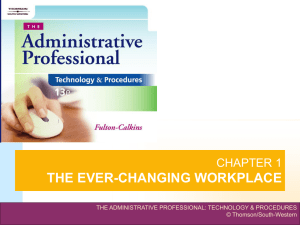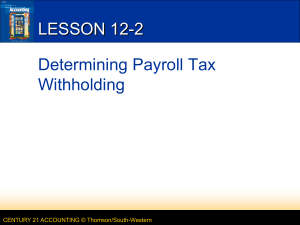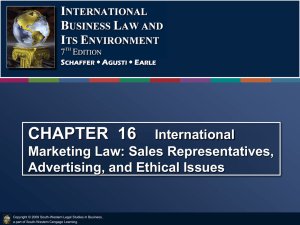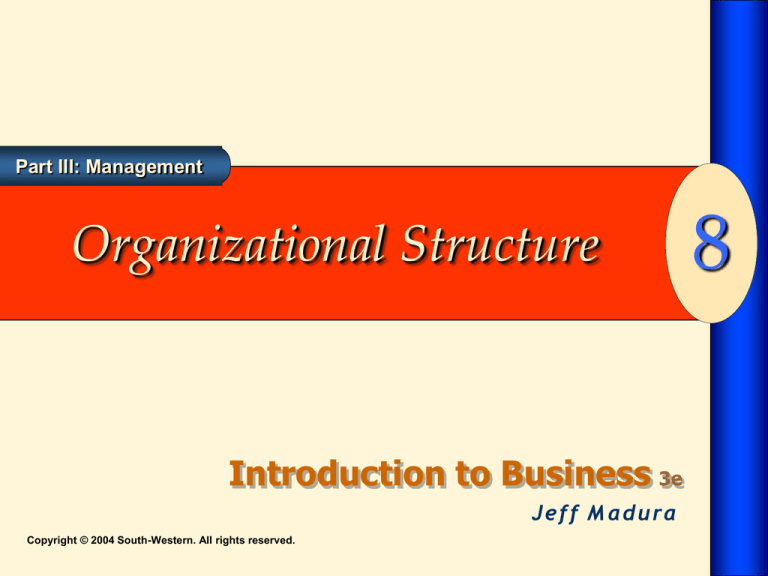
Part III: Management
Organizational Structure
Introduction to Business 3e
Jeff M a d ura
Copyright © 2004 South-Western. All rights reserved.
8
Learning Goals
•
Explain how an organizational structure
may be used by a firm to achieve its
strategic plan
•
Identify methods that can be used to
departmentalize tasks
Copyright © 2004 South-Western. All rights reserved.
8–2
Organizational Structure
Copyright © 2004 South-Western. All rights reserved.
8–3
Example of an Organization Chart
Copyright © 2004 South-Western. All rights reserved.
Exhibit 8.1
8–4
Structure and the Strategic Plan
•
Organizational structure identifies
responsibilities for each job position and
the relationships among those positions.
– Organization chart
A
diagram that shows the interaction
among employee responsibilities.
– Chain of command
Job
positions to which each type of
employee must report; indicates who is
responsible for various activities.
Copyright © 2004 South-Western. All rights reserved.
8–5
Chain of Command
•
President (and/or) CEO
– Has ultimate responsibility for firm’s success.
– Attempts to coordinate all divisions and
provide direction for the firm’s business.
•
Vice-Presidents
– Normally oversee specific divisions or broad
functions and report to the president.
– Chain of command ensures that managers
make decisions to maximize the firm’s value,
rather than serve their own interests.
Copyright © 2004 South-Western. All rights reserved.
8–6
Board of Directors
•
A set of executives responsible for
monitoring the activities of the firm’s
president and other high-level managers
– Directors are selected by share-holders to
serve as representatives for the
shareholders.
Copyright © 2004 South-Western. All rights reserved.
8–7
Small Business Survey
Who Are Board Members of Small Firms?
Copyright © 2004 South-Western. All rights reserved.
8–8
Board of Directors (cont’d)
Inside board members are also managers
of the firm.
• Outside board members are not
managers of the firm.
•
– Firms may partially compensate directors
with awards of stock to help motivate
directors to serve the interests of the firm’s
shareholders.
Copyright © 2004 South-Western. All rights reserved.
8–9
Board of Directors (cont’d)
•
Boards usually focus on major issues and
not day-to-day activities of the firm
– Approves key business proposals, such as
mergers and acquisitions.
– Can initiate changes in a firm, such as
replacing the CEO or restructuring the firm’s
businesses.
– Conflicts of interest can prevent board
members from making decisions that are in
the best interest of shareholders.
Copyright © 2004 South-Western. All rights reserved.
8–10
Other Elements of Structure
•
Internal auditor
– Responsible for ensuring that all
departments follow the firm’s
guidelines and procedures.
Copyright © 2004 South-Western. All rights reserved.
8–11
Other Elements of Structure
•
Span of control
– The number of employees managed by each
manager.
– Narrow spans of control have fewer
employees reporting to each manager than
do wide spans of control.
•
Organizational height
– Tall organizations have many layers.
– Short (or flat) organizations have few layers.
Copyright © 2004 South-Western. All rights reserved.
8–12
Distinguishing
between a Narrow
and Wide Span of
Control
Copyright © 2004 South-Western. All rights reserved.
Exhibit 8.3
8–13
Other Elements of Structure
•
Centralization
– Most authority is held by high-level
managers.
– Middle and supervisory managers are not
allowed to make many decisions.
•
Decentralization
– Authority is spread among several divisions
or managers.
– Autonomous divisions can make their own
decisions and act independently.
Copyright © 2004 South-Western. All rights reserved.
8–14
Decentralization
•
Advantages
– Reduces operating
expenses by eliminating
unnecessary positions
– Assigning power to lower
level employees can
shorten the decisionmaking process
– Delegation of authority
can improve employee
morale and decision
making skills
Copyright © 2004 South-Western. All rights reserved.
•
Disadvantages
– May force some managers
to make major decisions
even though they lack
experience or prefer not to
make such decisions
– Assigning an excessive
amount of responsibilities
to middle and supervisory
managers might make it
hard for them to complete
all of their tasks
8–15
Decentralization (cont’d)
•
Proper Degree of Decentralization
– Depends on the skills of the managers who
could be assigned more responsibilities
High
level managers should retain authority
for tasks requiring their specialized skills.
Routine decisions about tasks should be
made by employees closely involved with
the tasks; may lead to better decisions.
– Centralization is often necessary to allocate
resources to various divisions in the firm and
maximize the firm’s value.
Copyright © 2004 South-Western. All rights reserved.
8–16
Downsizing and Decentralization
•
Companies have attempted to cut
expenses by eliminating job positions
Downsizing
has resulted in flatter
organization charts with fewer layers of
managers.
Managerial jobs are eliminated and their
responsibilities are delegated to other
employees (decentralization).
Downsizing has increased managers’ span
of control and lead to the combination of
various job responsibilities.
Copyright © 2004 South-Western. All rights reserved.
8–17
Effect of Downsizing on Span of Control
Copyright © 2004 South-Western. All rights reserved.
Exhibit 8.4
8–18
Types of Organizational Structure
•
Line organization
– Contains only line positions
Job
positions are established to make
decisions that achieve specific goals.
•
Line-and-staff organization
– Includes both line and staff positions
Staff
positions support the efforts of line
positions.
– Assigns authority from higher-level
management to employees
Copyright © 2004 South-Western. All rights reserved.
8–19
Line Organization
Copyright © 2004 South-Western. All rights reserved.
Exhibit 8.5a
8–20
Line and Staff Organization
Copyright © 2004 South-Western. All rights reserved.
Exhibit 8.5b
8–21
Structure and Employee Input
•
Structure can be adjusted to obtain
greater employee input
– Matrix organization structure
Enables
various parts of the firm to interact
and focus on specific projects
Brings together employees with different
perspectives
No one employee may feel responsible for
project
Reduces time available for completing
normal tasks
Copyright © 2004 South-Western. All rights reserved.
8–22
A Matrix Organization for a Special Project
to Design a New Computer System
Copyright © 2004 South-Western. All rights reserved.
Exhibit 8.6
8–23
Structure and Employee Input
•
Intrapreneurship
Structure
can be adjusted to obtain greater
employee input
– Encouraging employees to offer ideas for
changes that enhance the firm’s value.
– Assigning employees to act as if they were
entrepreneurs running their own companies.
•
Informal Structure
Allows
employees to substitute for each
other to complete tasks on time.
Reduces amount of manager involvement.
Copyright © 2004 South-Western. All rights reserved.
8–24
The “grapevine”
•
The informal communication network
among employees
– Advantages
Friendships
increase job satisfaction
Allows information to flow from top to
bottom of the organization and vice versa.
– Disadvantages
Employees
may get incorrect or
unfavorable information.
Employee morale can be affected.
Copyright © 2004 South-Western. All rights reserved.
8–25
Departmentalizing Tasks
•
Assign tasks and responsibilities to
different departments
– By employee functions
– By type of product produced
– By geographic location
– By type of customer
Copyright © 2004 South-Western. All rights reserved.
8–26
Departmentalizing by Function
Copyright © 2004 South-Western. All rights reserved.
Exhibit 8.7
8–27
Departmentalizing by Product
Copyright © 2004 South-Western. All rights reserved.
Exhibit 8.8
8–28
Departmentalizing by Product and Function
Copyright © 2004 South-Western. All rights reserved.
Exhibit 8.9
8–29
Flow of Information Across Departments
Copyright © 2004 South-Western. All rights reserved.
Exhibit 8.10
8–30
Chapter Summary
•
Structure identifies responsibilities for
each job position and relationships
among positions
– Line-and-staff
– Matrix
– Intrapreneurship
•
Main methods of departmentalization
– Function
– Location
– Product
– Customer
Copyright © 2004 South-Western. All rights reserved.
8–31




